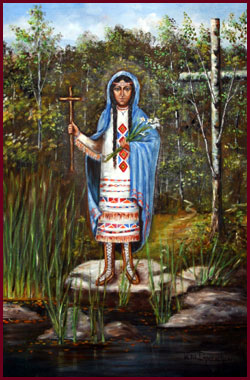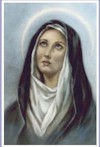|
|
|
Home
About Us
Contact Us
Catalog
Guestbook
Join the Online Prayer Group
Prayer Menu
Make a Gift Our Lady of Siluva Article and Resource Library "Silent Strength" Brochure Site Map |
 |
St. Kateri Tekakwitha St. Kateri Tekakwitha was a young Mohawk woman who lived in the 17th century. The story of her conversion to Christianity, her courage in the face of suffering and her extraordinary holiness is an inspiration to all Christians. |
|
Who was St. Kateri Tekakwitha? St. Kateri was born in 1656 of an Algonquin mother and a Mohawk Chief in upstate New York. When she was only 4 years old her parents and brother died of smallpox. St. Kateri survived with her face badly scarred and her eyesight impaired. Because of her poor vision, St. Kateri was named "Tekakwitha", which means "she who bumps into things". St. Kateri was taken in by her uncle who was bitterly opposed to Christianity. When St. Kateri was 18 years of age, she began instructions in the Catholic Faith in secret. Her uncle finally gave his consent for St. Kateri to become a Christian, provided that she did not try to leave the Indian village. She was baptized with the name St. Kateri (Catherine). Because of her Faith, St. Kateri was taunted by villagers and treated as a slave. Finally, she escaped to the Mission of St. Francis Xavier in Canada where she taught prayers to children and worked with the elderly and sick. She had great devotion to the Blessed Sacrament and to the Cross of Christ. She became known for her gentleness, kindness, and good humor. She asked the Blessed Mother to accept her as a daughter. She died on April 17th, 1680, shortly before her 24th birthday, and was buried in Quebec, Canada. St. Kateri's final words were. . . "Jesus — Mary — I love you." Witnesses reported that within a few minutes of her death, the pock marks from smallpox completely vanished and her face shone with radiant loveliness. St. Kateri had promised her friends that she would continue to love and pray for them in heaven. Both Native Americans and settlers immediately began praying for her heavenly intercession. Several people, including a priest who attended St. Kateri during her last illness, reported that St. Kateri had appeared to them and many healing miracles were attributed to her. |
Prayer
Asking the Intercession of O God, who among the many marvels of your grace in the New World did cause to blossom on the banks of the Mohawk and the St. Lawrence the pure and tender lily, St. Kateri Tekakwitha grant, we beseech you, the favor we beg through her intercession, that this young lover of Jesus will soon be counted among her Saints by Holy Mother Church, and that our hearts may be enkindled with a stronger desire to imitate her innocence and faith. Through the same Christ Our Lord, Amen. Imprimatur:
Most Rev. Howard J. Hubbard, DD |
|
The National St. Kateri Tekakwitha Shrine, Fonda, NY The Shrine is home to Franciscan Friars. Prayer Requests can be sent to info@katerishrine.org. The friars will place them before the friary altar and the statue of St. Kateria at the Shrine for their special attention. The original Caughnawaga, here in present day Fonda, NY, is the site of the village or “castle” where St. Kateri lived most of her life. It is the site of the only fully excavated Mohawk village of that era. Nearby, the holy spring, whose water was used to baptize her, still flows here. Many pilgrims claim cures after drawing its crystal clear water and praying through the intercession of St. Kateri. St. Kateri lived in Caughnawaga until 1677, when she fled to Kahnawake, a Christian village in Quebec, Canada, called “The Village of the Praying Indians.” | |
|
Words of St. Kateri St. Kateri said: “I am not my own; I have given myself to Jesus. He must be my only love. The state of helpless poverty that may befall me if I do not marry does not frighten me. All I need is a little food and a few pieces of clothing. With the work of my hands I shall always earn what is necessary and what is left over I’ll give to my relatives and to the poor. If I should become sick and unable to work, then I shall be like the Lord on the cross. He will have mercy on me and help me, I am sure.” She was beatified by St. Pope John Paul II in 1980. Pope Benedict XVI has officially announced that she will be canonized on October 21, 2012. |
|
